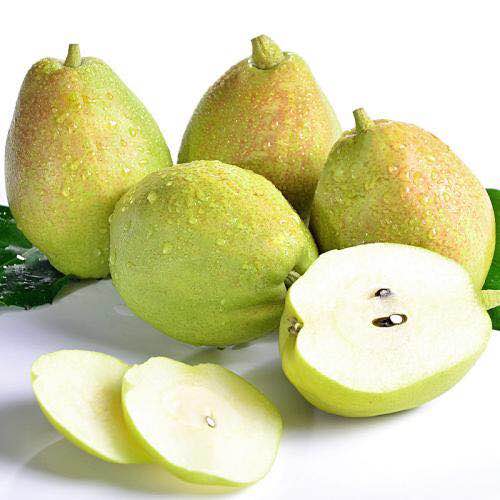China's geographic indication products

Korla pear

Name: Korla Fragrant Pear
Place of origin: Kurla City, Aksu City, Alar City, Yuli County, Luntai County, Kuche County, Shaya County, Xinhe County, Awati County, and Wensu County in Xinjiang Uygur Autonomous Region
Product description: Korla Fragrant Pear is a unique pear only grown in Xinjiang. Its fruit is rich in flavor, sweet and juicy, and rich in minerals, vitamins, amino acids and other trace nutrients. The Korla fragrant pear is small; the average single fruit weight is 110 grams, and it has an irregular shape, generally round, oval or spindle-shaped. The peel is green, and the pulp is white. Its fruit tastes crisp and refreshing and it has high storage tolerance.
Natural and humanistic factors:
The planting area of the Korla Fragrant Pear is located in the northern margin of Tarim Basin and the southern foot of Tianshan Mountain with an altitude of 850-1125 meters. It is a piedmont alluvial fan oasis zone. And the water source of the pear is from Tianshan snow water, which flows from north to south, and forms a wide network distribution from west to east. The irrigated oasis belongs to the continental dry climate in the warm zone. The annual total radiation reached more than 6000 MJ/m2, and the sunshine exposure time of the fragrant pear in August is about 300 hours.
Lots of mysterious and cultural legends about the Korla Fragrant Pear have been created by different nations, carrying a love for the homeland and hopes for a better life.
Maotai liquor

Name: Maotai
Place of origin: 15.03 km2in Maotai Town, Renhuai City, Guizhou Province
Product description:
(1) The raw material of Maotai:
1) Glutinous sorghum produced in Jinsha County and Xishui County with starch content of not less than 60%, and a proportion of amylopectin in the starch of not less than 88%.
2) Wheat starch content is not less than 60%.
3) Water from the confluence of Chishui River and Yanjin River.
(2) Brewing environment
Laterite area with the altitude of 420-600 meters above sea level
(3) Characteristics
Maotai tastes rich and delicate with a long aftertaste, it also offers an exceptionally pure, mild, and mellow soy sauce-like fragrance that lingers after consumption.
Natural and humanistic factors:
In 1996, Maotai Liquor Technology was designated as a protected state secret. In 2001, the traditional technology of Maotai liquor was listed in the first batch of national material and cultural heritages. In 2006, Maotai Liquor Traditional Brewing Technology was listed in the national intangible cultural heritage lists and was submitted by the State Council for status as a world intangible cultural heritage.
Jinhua ham

Name: Jinhua ham
Wucheng District, Jindong District, Lanxi City, Yongkang City, Yiwu City, Dongyang City, Wuyi County, Pujiang County and Pan'an County under the jurisdiction of Jinhua City. Kecheng District, Jiangshan City, Quzhou County, Longyou County, Changshan County and Kaihua County under the jurisdiction of Quzhou City.
Product description:
Jinhua ham has bright color, the lean meat of the ham is sweet and salty, and the fat of the ham is delicious but not greasy. It also contains rich protein, fat, multi-vitamins and minerals. The ratio of lean meat is no less than 60%, and salt content is no more than 11g/ KG.
Natural and humanistic factors:
The production of Jinhua ham started in the Tang Dynasty and has a history of more than 1200 years. In 1905, Jinhua ham won the gold medal at the World Exposition, Germany. It also won the certificate of the Nanyang Persuasion Trade Fair in 1913, the gold medal of the Panama International Commodity Fair in 1915, and the special prize of the Hangzhou West Lake International Exposition in 1929. In 2008, "Jinhua Ham Salting Techniques" was listed in the second group of national intangible cultural heritages by the State Council.




